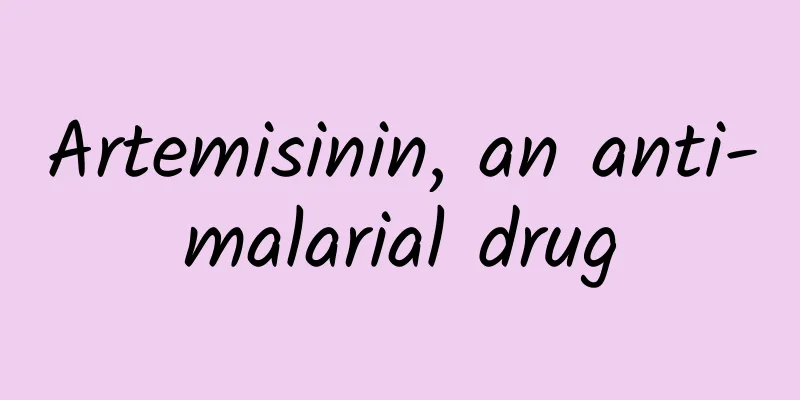Artemisinin, an anti-malarial drug

|
Since ancient times, humans have been waging a long struggle against malaria, which was recorded in the Yellow Emperor's Classic of Internal Medicine - Suwen as early as BC. Until now, malaria is still rampant in many countries in the world, threatening people's health and lives. On October 5, 2015, the Karolinska Institute in Sweden announced that the 2015 Nobel Prize in Physiology or Medicine would be awarded to Chinese pharmacist Tu Youyou and two other overseas scientists in recognition of their contributions to the research on the treatment of parasitic diseases such as malaria. Tu Youyou also became the first Chinese scientist to receive this award. Before the discovery of artemisinin, quinine and chloroquine were the main antimalarial drugs used. However, the success of drugs such as quinine and chloroquine in treating malaria did not last long. In the 1960s, drug-resistant malarial parasites began to appear in many areas, especially in Southeast Asia and Africa, and there were even no effective drugs available. Since then, the development of new antimalarial drugs has become crucial[1]. In 1972, Tu Youyou and her research team screened more than 2,000 Chinese herbal medicine prescriptions and found that the extract of Artemisia annua from the Asteraceae plant had a certain inhibitory effect on mouse malarial parasites, but it was speculated that the concentration of the active ingredient was too low due to improper extraction methods. Later, inspired by Ge Hong, a medical scientist in the Eastern Jin Dynasty of my country, they switched to low-temperature ether extraction method and successfully extracted artemisinin, the active ingredient for treating malaria. The inhibitory rate of this extract on malarial parasites reached 100%[2]. Artemisia annua, also known as stinking wormwood and bitter wormwood, is an annual herbaceous plant belonging to the Asteraceae family and is common in both northern and southern China. As early as the 2nd century BC, the Chinese pre-Qin medical prescription book "Fifty-two Prescriptions for Diseases" had already recorded the plant Artemisia annua. In 340 AD, Ge Hong of the Eastern Jin Dynasty first described the antimalarial function of Artemisia annua in his book "Emergency Prescriptions for Treating Cold, Heat and Malaria". In the second half of 1971, Tu Youyou was inspired by the record in "Emergency Prescriptions for Treating Cold, Heat and Malaria" that "take a handful of Artemisia annua, soak it in two liters of water, squeeze out the juice, and drink it all". She believed that high temperature might affect the effective ingredients of Artemisia annua and affect the efficacy, so she changed the extraction method from ethanol to ether, which has a lower boiling point than ethanol[3]. Compared with other antimalarial drugs, artemisinin-based drugs have the effect of efficiently and quickly eliminating malarial parasites. However, due to their short half-life in the body, in order to completely eliminate malarial parasites while slowing down the development of resistance, researchers recommend the use of artemisinin and its derivatives in combination with other antimalarial drugs. In 2004, the Lancet magazine reported that the cure rate of falciparum Plasmodium falciparum treated with artesunate in combination with other drugs reached over 80%, and the relapse rate and gametocyte infection rate were also significantly reduced [4]. As of 2013, 79 of the 87 countries in the world where falciparum malaria is endemic have adopted artemisinin-based combination therapy as the first-line drug for the treatment of falciparum malaria. Artemisinin has created a new generation of antimalarial drugs. It comes from traditional Chinese medicine. Its discovery has saved the lives of millions of people around the world, especially in developing countries. I believe that with the continuous efforts of scientific researchers and medical staff, global malaria will be controlled and even eliminated. References [1] Wu Yulin. Artemisinin: a wonder of Chinese herbal medicine, the antidote to malaria. University Chemistry, 2010, 25: 7 [2] Zhang Jianfang. Late report: A record of the 523 project and the development of artemisinin. Late report: A record of the 523 project and the development of artemisinin, 2015 [3] Hou Guinan. Tu Youyou: The discovery of artemisinin is a gift from traditional Chinese medicine to mankind. University Science Popularization, 2011, 5: 1 [4] Huang Fang, Zhou Xiaonong. The status and role of artemisinin in global malaria control. Science Bulletin, 2016, 3 |
<<: What are the benefits of heavy snow? What to eat to keep warm in heavy snow
Recommend
Treatment of a large lump on the genitals
I believe everyone must know the importance of th...
Revealed! Embarrassing things that women do in the delivery room
Maybe you have learned something about childbirth...
What should I pay attention to if my cervix is short?
Short cervix is actually a developmental diseas...
I take a walk after three meals a day, but my heart vessels are still blocked. What's going on?
I take a walk after three meals a day, but my hea...
What causes pain on both sides of the uterus?
When dealing with the symptoms of pain on both si...
What is the normal thickness of the endometrium after medical abortion?
There are often many unexpected things happening ...
Women with cold uterus like to wear this thing
The characteristics of women with uterine cold re...
How to eat loofah nutritiously and deliciously? 5 ways to eat loofah
Sponge gourd can be fried, made into soup, cooked...
What should I eat when my aunt is eating less?
Small amount of menstrual discharge is the cause ...
Femoral bone is several weeks shorter and diagnosed as deformity
After pregnancy, everyone needs to do B-ultrasoun...
How to deal with frequent uterine contractions during mid-pregnancy
From pregnancy to the second trimester, you need ...
Everyone is familiar with oral herpes, but can herpes also develop on the genitals?
Author: Wu Hao, Chief Physician, Beijing You'...
Why do I feel short of breath after getting pregnant?
Pregnant women will experience some physical symp...
Normal underwear secretion picture
Female secretions are the fluid secreted by the f...
Will a grade 3 breast nodule become a grade 4?
Breast nodules are generally a common disease in ...









